There are four major deserts in North America; the Chihuahuan Desert (Northern-Central Mexico and southwestern Texas), the Sonoran Desert (southern Arizona and northern Mexico), the Mojave Desert (Southern California, Baja California, and western Arizona), and the Great Basin Desert of Utah and Nevada with isolated pieces extending as far north as southern British Columbia.
The deserts of North America are characterized as either "hot desert" or "cold desert". The Sonoran, Mojave, and Chihuahuan Deserts are classified as "hot deserts", and the Great Basin Desert as "cold desert".
The Sonoran Desert is an arid region covering 120,000 square miles in southwestern Arizona and southeastern California, as well as most of Baja California and the western half of the state of Sonora, Mexico. Subdivisions of this hot, dry region include the Colorado and Yuma deserts.
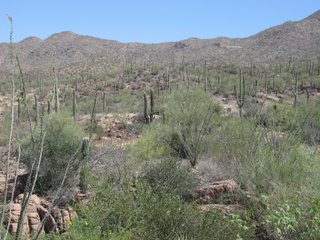
Sonoran Desert Landscape
This is the hottest of the North American deserts, but a distinctly bimodal rainfall pattern produces a high biological diversity. Winter storms from the Pacific nourish many West Coast annuals such as poppies and lupines, while well-developed summer monsoons host both annuals and woody plants originating from the south. Freezing conditions can be expected for a few nights in winter.
Trees are usually well developed on the desert ranges and their bajadas. Often abundant on these well-drained soils are Little-leaf Palo Verdes, Desert Ironwoods, Catclaw and Saguaro.
The understory consists of three, four or even five layers of smaller woody shrubs. Tall chollas may occur in an almost bewildering array of species. The alluvial lowlands host communities of Desert Saltbush, wolfberry and bursage. On coarser soils, Creosote Bush and bursage communities may stretch for miles. Where the water table is high, Honey or Velvet Mesquite may form dense bosques or woodlands.
Other species are restricted to alkaline areas. Stream sides may be lined with riparian woodlands composed of Arizona Ash, Arizona Black Walnut, Fremont Cottonwood and various willows, with a dense understory of Arrow-weed, Seepwillow and Carrizo. The Sonora Desert is rich in animal life as well, with many species in all groups derived from tropical and subtropical regions.
The western part of the Sonora Desert (sometimes called the "Colorado Desert") is closer to the source of Pacific storms and is noted for spectacular spring flowering of ephemerals when there is winter-spring rainfall. However, the western portion is relatively depauperate, lacking many of the species such as the Saguaro that depend on good summer rainfall.
Reference: http://www.desertusa.com/du_sonoran.html
The desert vegetation in and around Tucson was varied and particularly interesting to one who had an interest in horticulture and who had never been in a desert environment before.
The following describes the most obvious and prolific plantlife in the area.
Two species of palo verde commonly occur in the Southwest: the foothill, yellow or littleleaf palo verde and the blue palo verde. Palo verde, Spanish for green wood or stick, describes the plant’s greenish branches and trunk.
Both species are spiny, green, multi-trunked, deciduous trees. Foothill palo verdes only reach about 7m in height and have more yellowish bark and duller yellow/white flowers. Blue palo verdes top out at 12m. Their twigs and young branches are bluish-green, as are the leaves, which are larger than the foothill variety. Pods contain from one to eight seeds, with one being far more common than eight. The foothill species pods have narrow waists between the seeds, which are lentil sized. Blue palo verde seeds are slightly larger and flatter, with thicker, harder shells.
The blue palo verde species grows primarily in washes. It requires more water than the foothill species, which grows more commonly in the uplands. The blue species occurs principally in fine soils, and the foothills species, in coarser soils. Foothill palo verdes often live for over 100 years and may reach 400 years. In contrast, blue palo verdes grow faster and die sooner, rarely reaching the century mark.

Palo Verde
During their short flowering seasons, both species are clothed with thousands of five-petaled yellow blossoms. They attract numerous pollinators, including beetles, flies and social and solitary bees.
The trees can photosynthesize through their green bark, an important adaptation for a tree that drops its leaves during the warm season and in response to fall cooling. Palo verdes also drop stems and branches to combat drought.
Palo verdes serve as nurse plants for saguaro cacti by providing a canopy – in effect, a microhabitat – which offers warmth in winter and shade in summer. The slower-growing, longer-lived cactus will eventually replace its one-time protector.
Reference: http://www.desertusa.com/mag01/aug/papr/palov.html
The Ocotillo is a bajada resident that can be relied on to bloom annually, even without leafing in particularly dry springs. It is an inverted, funnel-shaped desert plant with several woody, spiny, whip-like, straight branches angling outward from the base and rising as high as 7m.
Red flowers are 12mm to 25mm in length, with five short lobes curled back into 25cm clusters. They appear at the ends of branches March through June or later, depending on rainfall.

Ocotillo
Ocotillo are leafless most of the year, except immediately after rain; the leaves then quickly wither after the soil dries out. These narrow, oval leaves are about 2 inches long, appearing in bunches above spines.
Mature plants have as many as 75 slender branches (canes). Planted in rows, Ocotillo become living fences.
Reference: http://www.desertusa.com/nov96/du_ocotillo.html
The Creosote Bush is the most characteristic feature of North America's hot deserts. It is one of the best examples of a plant that tolerates arid conditions simply by its toughness. It competes aggressively with other plants for water, and usually wins, accounting for its prevalence in many arid locations of the southwest.
This medium-to-large evergreen shrub has numerous flexible stems projecting at an angle from its base. It is usually less than 1.5m high, but can grow to 4m heights with abundant water.

Creosote Bush
Its small, pointed, yellow-green leaves have adapted to conserve water and dissipate heat. The bush may lose some of these waxy, resinous leaves during extreme drought, but never loses them all. These leaves are especially pungent after a rain, and have been used as antiseptics and emetics by native peoples. Its foliage provides refuge for crickets, grasshoppers and praying mantids.
Flowers are 25mm wide twisted, yellow petals bloom from February-August. Some individuals maintain flowers year round. After the Creosote blooms the flower turns into a small white fuzzy fruit capsule that has 5 seeds.
Reference: http://www.desertusa.com/creoste.html
Over 300 species of Agave have been described, but only about 200 are currently recognised. They are succulents but not cacti. Most species are monocarpic, although a few can flower several times during their life. This differentiates them from the Yucca which although very similar in appearence, flowers annually. The flowers are "perfect" with both male and female parts. Many species of Agave are bat pollinated and produce musky perfumes as attractants. Others produce sweeter odours to attract insects.
Most Agaves consist of rosettes of thick, hard, rigid leaves often with marginal teeth and usually with a lethally sharp terminal spine. Prolific vegetative growth and offsetting at the base of the plant or through stolons, usually maintains a clump of plants thus compensating for loss of flowering rosettes. A few species remain solitary, relying on seed production for survival of the species.
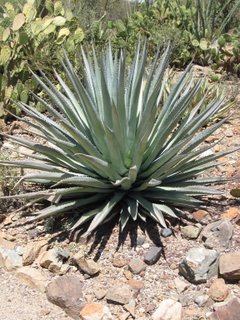
Agave
Carbohydrates stored in the core of several species of Agave were fermented by native Americans to make a beverage called pulque which was used in religious ceremonies. Distillation of a similar ferment made from the developing Agave flower bud is the basis for modern production of Mescal. Only if made from the Blue Agave within the Tequila region of Mexico can the distillate be called Tequilla.
Reference: http://www.succulent-plant.com/agave.html
All but one species of cacti are native to the New World and their habitat extends from Canada to Argentina. All cacti are succulents but not all succulents are cacti.
The magnificent Saguaro Cactus, the state flower of Arizona, is composed of a tall, thick, fluted, columnar stem, 45 to 60 cm in diameter, often with several large branches (arms) curving upward in the most distinctive conformation of all Southwestern cacti.
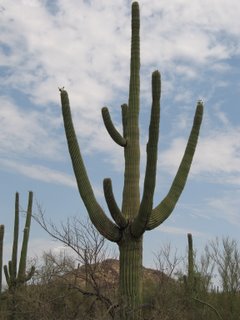
Sagauro Cactus
The skin is smooth and waxy, the trunk and stems have stout, 2-inch spines clustered on their ribs. When water is absorbed , the outer pulp of the Saguaro can expand like an accordion, increasing the diameter of the stem and, in this way, can increase its weight by up to a ton.
The Saguaro grows very slowly, perhaps an inch a year, but to a great height, 5 to 15m. The largest plants, with more than 5 arms, are estimated to be 200 years old. An average old Saguaro would have 5 arms and be about 6m tall.
The Saguaro has a surprisingly shallow root system , considering its great height and weight. It is supported by a tap root that is only a pad about 1m long, as well as numerous stout roots no deeper than 30cm, emanating radially from its base. More smaller roots run radially to a distance equal to the height of the Saguaro. These roots wrap about rocks providing adequate anchorage from winds across the rocky bajadas.
The slow growth and great capacity of the Saguaro to store water allow it to flower every year, regardless of rainfall. The night-blooming flowers have many creamy-white petals around a tube about 10cm long. Like most cactus, the buds appear on the southeastern exposure of stem tips, and flowers may completely encircle stems in a good year.

Sagauro Cactus in Flower
A dense group of yellow stamens forms a circle at the top of the tube; the Saguaro has more stamens per flower than any other desert cactus. A sweet nectar accumulates in the bottom of this tube. The Saguaro can only be fertilized by cross-pollination -- pollen from a different cactus. The sweet nectar, together with the color of the flower, attracts birds, bats and insects, which in acquiring the nectar, pollinate the Saguaro flower.
The oval, green fruit ripens just before the fall rainy season, splitting open to reveal the bright-red, pulpy flesh which all desert creatures seem to relish. This fruit was an especially important food source to Native Americans of the region who used the flesh, seeds and juice. Seeds from the Saguaro fruit are prolific -- as many as 4,000 to a single fruit -- probably the largest number per flower of any desert cactus.
Reference: http://www.desertusa.com/july96/du_saguaro.html
Cholla cactus represent more than 20 species of the Opuntia genus (Family Cactacea) in the North American deserts. Cholla is a term applied to various shrubby cacti of this genus with cylindrical stems composed of segmented joints. These stems are actually modified branches that serve several functions; water storage, photosynthesis and flower production.
Like most cactus, chollas have tubercles, small wart-like projections on the stems from which sharp spines, actually modified leaves, grow. But chollas are the only cactus with papery sheaths covering their spines. These sheaths are often bright and colorful, providing the cactus with its distinctive appearance.
Opuntia are unique because of their clusters of fine, tiny, barbed spines called glochids. Found just above the cluster of regular spines, glochids are yellow or red in color and detach easily from the pads or stems. Glochids are often difficult to see and more difficult to remove, once lodged in the skin.

Teddy Bear Cholla
Most cholla cactus have orange or greenish-yellow flowers with a variety of colors, even among the same species. Most species bloom April through June, depending on local conditions. Stems and joints vary in width, length, shape, and color, as well as in the profusion of spines and glochids. Chollas may appear as ground creepers, shrubs or trees, varying in height from less than a foot (Club or Devil Cholla) to as much as 5m (Chain-Fruit Cholla).
Teddy Bear or Jumping Cholla is said to resemble the fuzzy arms and legs of a Teddy Bear, it can be distinguished by its dense, straw-colored spines and yellow to green flowers.
Reference: http://www.desertusa.com/mag99/may/papr/chollas.html
Prickly pear cactus represent about a dozen species of the Opuntia genus (Family Cactaceae) in the North American deserts. All have flat, fleshy pads that look like large leaves. Like other cactus, most prickly pears have large spines, modified leaves, growing from tubercles which are small, wart-like projections on their stems. Members of the Opuntia genus are unique because of their clusters of fine, tiny, barbed spines called glochids. Found just above the cluster of regular spines, glochids are yellow or red in color and detach easily from the pads. Glochids are often difficult to see and more difficult to remove, once lodged in the skin.
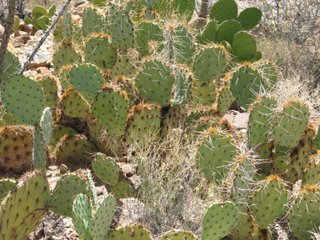
Prickly Pear
The fruits of most prickly pears are edible and sold in stores under the name "tuna." Prickly pear branches (the pads) are also cooked and eaten as a vegetable. They, too, are sold in stores under the name "Nopalito."
Reference: http://www.desertusa.com/magoct97/oct_pa/du_prkpear.html
Ferocactus, meaning "fierce or wild cactus,"are always cylindrical or barrel shaped and are usually among the largest cacti of the North American deserts. All members of this genus have prominent ribs and are fiercely armed with heavy spines. In some species, one or more central spines are curved like a fishhook, accounting for the common name Fishhook Barrel Cactus.
Barrel Cactus flowers always grow at the top of the plant. They bear no spines and only a few scales. Fruits become fleshy and often juicy when mature, but are not usually considered edible.

Fish Hook Barrel Cactus
Native Americans boiled young flowers in water to eat like cabbage and mashed older boiled flowers for a drink. They also used the cactus as a cooking pot by cutting off the top, scooping out the pulp and inserting hot stones together with food. The spines were used as needles, awls and in tattooing.
The pulp of barrel cactus has been widely used for making cactus candy (thus one of its common names, Candy Barrel Cactus), but this has also accounted for its destruction and, therefore, protected status in many areas.
Reference: http://www.desertusa.com/mag99/june/papr/barrelcactus.html
Organpipe cactus is a columnar cactus which is the second largest in the U.S.A (next to the Saguaro) growing as tall as 8m. Instead of having a central stem, however, a cluster of 5 to 20 slender branches grow from a point at ground level and curve gracefully upward.
These water-storing trunks are about 15cm in diameter and have 12 to 17 deep-green, rounded ribs. The areoles are set close together with 9 or 10 brown radial spines that turn gray with age.
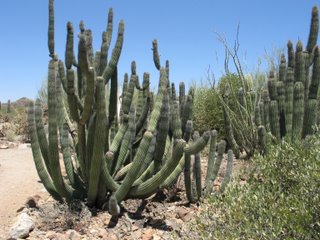
Organpipe Cactus
Fruits lose their spines at maturity, opening to display an edible red pulp. This fruit has provided a food source to Native Americans for centuries. The pulp can be eaten as is, made into jelly or fermented into a beverage.
Reference: http://www.desertusa.com/aug96/du_organpipe.html














